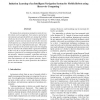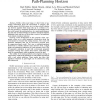10 search results - page 2 / 2 » Obstacle Avoidance Behavior for a Biologically-inspired Mobi... |
SBRN
2008
IEEE
13 years 11 months ago
2008
IEEE
The design of an autonomous navigation system for mobile robots can be a tough task. Noisy sensors, unstructured environments and unpredictability are among the problems which mus...
CEC
2007
IEEE
13 years 11 months ago
2007
IEEE
Abstract— Designing effective behavioral controllers for mobile robots can be difficult and tedious; this process can be circumvented by using unsupervised learning techniques w...
ICAT
2003
IEEE
13 years 10 months ago
2003
IEEE
This paper presents a new type of wearable telepresence system that is applicable to the control of a humanoid robot. The system consists of self-contained computing hardware with...
IROS
2006
IEEE
13 years 10 months ago
2006
IEEE
Abstract— Mobile robots need maps or other forms of geometric information about the environment to navigate. The mobility sensors (LADAR, stereo, etc.) on these robotic vehicles ...
IROS
2006
IEEE
13 years 10 months ago
2006
IEEE
— Current approaches to the visual homing for mobile robot navigation are generally inspired in insects’ behavior and based on the observed angular information of fixed points...


